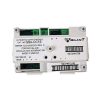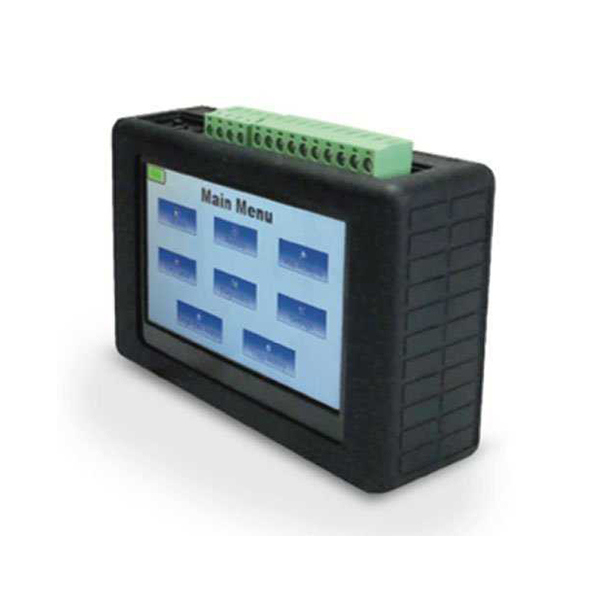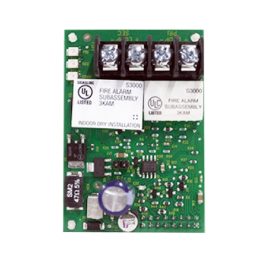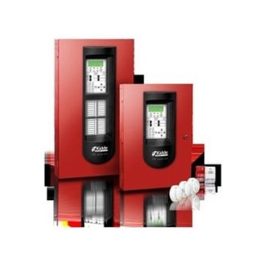Kidde KI-HDT Handheld Diagnostic Tool
Key Features:
- Manipulates, tests, and monitors Signature SLC and connected devices
- Ideal for system verification and troubleshooting
- Compact, easy-to-use for factor
- Bright touch-screen graphical user interface
- Easy-access terminal blocks for field wiring
- Rechargeable lithium-ion battery
- Includes PC software for report generation and data management
- 8 now adds selectability to Optica normal LED flashing
- 8 brings increased diagnostics for locating wiring faults
Description
The Kidde KI-HDT Handheld Diagnostic Tool is a compact and easy-to-use diagnostic tool that assists installation and troubleshooting EDWARDS Signature Series device loops and connected devices. The KI-HDT is a hand-held unit, and features a touch screen that makes it possible for the operator to manipulate, test, and monitor the Signature loop in the field using live data in real time.
The KI-HDT Handheld device comes with PC-compatible software that generates detailed reports for archiving or further diagnostic analysis. Data collected and stored on the KI-HDT Tool may be downloaded from the unit directly to a laptop or desktop computer via USB cable, or it may also be saved to a USB Flash drive for later use off-site.
Terminal blocks on top of the unit provide easy connection of field wiring, while USB 2.0 and Micro-B ports provide an interface for data exchange, and power. Kidde’s KI-HDT is powered by a rechargeable lithium-ion battery.
Application
The KI-HDT Handheld Diagnostic Tool is ideal for verifying new projects, troubleshooting existing installations, or testing retrofits. It can be used to initialize the Signature loop before connecting to a control panel, or it can be used for diagnosis and troubleshooting after loop connections are made to the controller.
In operation, the KI-HDT performs the following functions:
- Initializes the loop (i.e. identifies all devices connected to the SLC)
- Restores the loop
- Performs Map Analysis on detectors and modules (contact analysis and map consistency) and identifies failed units
- Performs Dirty Level analysis on photo detectors and identifies detectors that require cleaning
- Allows the user to program new device address to a detector or module
- Performs maintenance on a single detector or module
- Reinitializes the device address of detectors or modules on a loop to zeros
- Single device diagnostics
- Loops history, etc.
Operation
The KI-HDT Main Menu displays high level testing and diagnostics options.
Initialize
The initialize loop function enables the device to perform some initial actions such as resetting all devices and opening all isolators. This function uses the device serial number to assign new, short addresses, read device address, version numbers, device types, shorts on the SLC, and checks for ground fault on the SLC loop. The initialized data is stored in the “Stored Database Info” page of the display and can be accessed by pressing the Loop History button.
Restore
The Restore loop function closes all isolators and checks all device statuses on the loop.
Map Analysis
The KI-HDT Diagnostic Tool provides two methods of investigating a new or existing loop installation. These methods help pinpoint specific devices that are causing map faults or have the potential to cause a future map fault. The map fault analysis function performs the following two diagnostic tests:
Map Consistency
The map consistency function maps each device on the Signature loop three times and compares the responses of all three readings to see if there is a mismatch. If a device is not responding consistently, it is flagged as failed and an investigation is required.
Contact Analysis
The contact analysis function tests the response measured by listening device(s) when the annunciating device is activated. The response is an indirect measurement of the contact resistance and can be used to identify existing mapping issues or devices that have the potential to cause an issue in the future.
Dirty Level
This function is only associated with optical detectors. It enables the user to determine the dirty level of each optical detector on the loop. After the successful execution of this function, the KI-HDT erases the old database of Dirty Levels and replaces it with the new Dirty Level data.
Diagnostics
The Diagnostic Menu holds functions that enable a user to run diagnostics on the Signature devices on the connected loop. The functions below can be performed within the diagnostic menu screen.
Normalize Photo Function
This function normalizes (writes the new clean air count into memory). After cleaning the detector using the approved tools or method, the user can connect the detector(s) back to the loop and initiate this function to normalize the photo value.
Single Device Function
The single device function allows a user to diagnose a single device within a loop or outside a loop. The single device function consists of five sub-functions that include: Read EE data, Photo A/D value, Program Device Address, Program Maintenance date, and Trouble Codes.
Read EEPROM Function
The Read EEPROM function is an advanced function that may be requested by technical support or engineering.
Reinitialize Function
This function is useful if the user needs to reset all device addresses on the loop to zero.
Program Maintenance Date
This function is useful when a user performs maintenance on a photo detector and needs to update the maintenance date register on the detector.
Trouble Codes
The Trouble Code function enables the user to understand the trouble condition, the possible cause, and possible solution to resolve the trouble. Trouble Codes are displayed during the Restore Loop execution
Settings
The Settings screen displays current date and time. The KI-HDT needs to be connected to the computer software to sync the time and date. The interface and GUI board versions along with the battery status, loop output voltage and current are displayed
Single Device History
The “Single Device History” displays data only when the single device Read EE Data function was performed. The database stores each single device’s Short Address (SA), Operation Hours (OpHrs), Alarm, Last Alarm Bytes, and Alarm Originator. When there is no alarm status, N/A is displayed on the Alarm, Last Alarm Bytes, and Alarm originator respectively.
Loop History
The Loop History function takes the user to the Stored Database Screen; this screen shows the device information stored in the memory of the SIGA-HDT. If no actions (Initialize, map analysis, etc.) have been performed previously, no data is displayed in the database.
Kidde KI-HDT PC Software
The SIGA-HDT comes with PC-compatible software that may be used for firmware updates as well as importing data from the device for saving to the PC.
Now with v1.8, programmers can use this software and the HDT to select the LED inhibit feature of Signature Optica detectors. This allows for turning off normal green polling led applications that require no background flashing in non-emergency conditions. (Requires detectors with 1.0.16 or later firmware.)
Additionally, new diagnostics to quickly locate mapping faults on SLC loops reduces technician trouble shooting time.
The user can import three categories of data:
- Device EEPROM Data
- KI-HDT Report Data: The KI-HDT Report contains all the device information, the dirty level for each photo detector on the loop and mapping data.
Single Device Data: This function imports the single device history data saved in the KI-HDT internal memory to the Signature Diagnostic Tool software.
You must be logged in to post a review.






Reviews
There are no reviews yet.